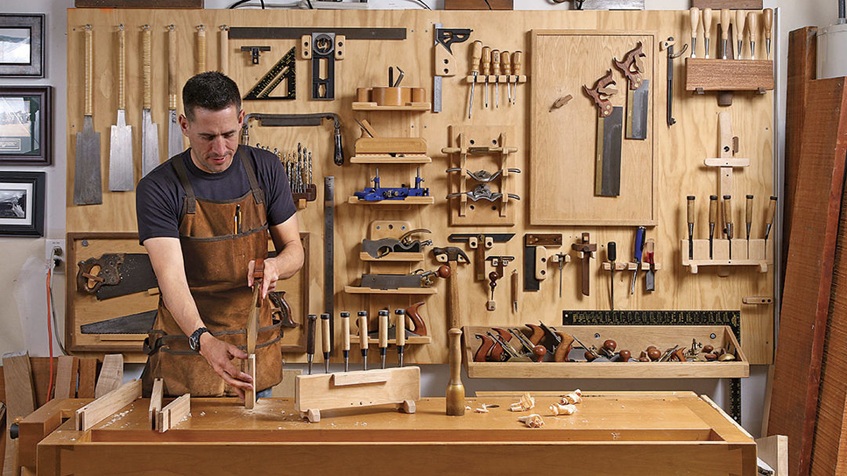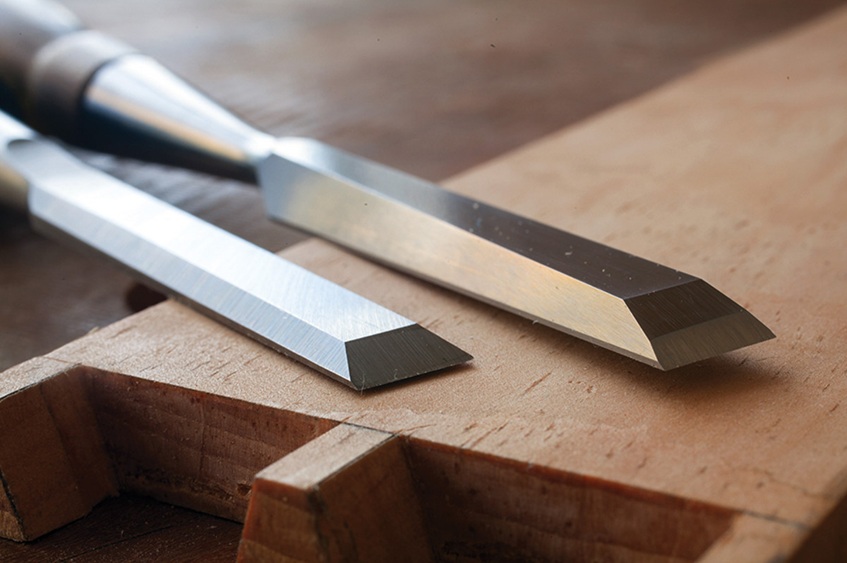
Hand Tools: A Woodworker’s Trusted Solution
Ask any long-time woodworker how they honed their skill, and they’ll proudly profess that it was with ordinary tools. Before the widespread inclusion of cordless routers, mitre saws, and planers in their toolboxes, woodworkers relied almost exclusively on handheld tools. And not surprisingly, they’re still the preference of chippies, cabinetmakers, and hobbyists alike who prefer keeping woodworking as practical as possible.
The fact is, even with the wealth of corded and cordless tools at woodworkers’ disposal, there are times when ordinary steel tools are the best option. Whether it’s restoring the intricate moulding around an antique door, or correcting a builder’s door casing that’s grotesquely out of square, hand tools are as much about convenience as they are about precision. They can go anywhere and do anything, and they take up almost no space in the process.
Contents
Hand Tools Give Woodworkers the Advantage of Efficiency

Let’s be honest: while modern power tools excel at the kinds of repetitive/high throughput jobs that professional woodworkers need to perform, the truth is they can’t compete with the flexibility that premium quality hand tools offer for all levels of woodworkers. They make it possible to get professional results without using cumbersome power tools that can be overly aggressive to wood stock.
And for a broad swath of woodworkers, even at the professional level, hand tools continue to be the preference for all but the most redundant cutting jobs. Not surprisingly, there’s no shortage of pride or romanticism that goes with working wood by hand. The preference for a woodworking hand tool, however, has more to do with efficiency than sentiment. Woodworkers want tools that they can use anytime, anywhere, and these tools boast an array of advantages that power tools can’t compete against:
- No space restraints. Whether it’s during transport, storage, or while setting up a workbench, they take up only a fraction of the space that power tools do.
- Light weight and no noise. Although today’s cordless power tools are lighter and quieter than ever, handheld ones weigh almost nothing and make almost no noise whatsoever.
- Easy clean ups. The regular alternative doesn’t create the staggering amounts of fine dust that power tools do, making cleanups easier and quicker.
- No power, no problem. With hand tools, woodworkers aren’t burdened with the availability of GPOs, or the need to invest in reserve batteries.
- Affordability. Price is arguably hand tools’ biggest advantage, as the cost to purchase and maintain a set of power tools to do the job of a few basic handheld tools can cost thousands of dollars.
Make no mistake: hand tools are the original power tools. A properly designed woodworking hand tool can cut, plane, and chisel as well as any power tool with maximum simplicity, and twice the precision. And with only a small core of sawing, levelling, and carving tools needed for the finest woodworking jobs, even beginning woodworkers can carve out the most delicately detailed results without breaking a sweat.
High-Quality Hand Saws Are the Key to Fine-Cutting
Hand saws are the primary tools used for making straight and slightly curved cuts, and for creating simple joints like tongues, dovetails, and dados. Teeth per inch (TPI) counts are what matters when it fine-cutting saw work, and there are three main types of saws that woodworkers trust for their most detailed work:
- Pull saws. Narrow single- and double-sided pull saws, sometimes referred to as Japanese saws, are designed to cut on the pull stroke, and feature tooth counts up to 25TPI for the finest-edged finishes.
- Tenon saws. 20TPI tenon saws are commonly known as back saws, and are constructed with broad flat blades and rigidly reinforced top edges for precise cutting jobs like dovetails, and tenon and mitre cuts.
- Coping/fret saws. These U-shaped hand saws use thin, flexible cutting blades that boast tooth counts to 20TPI, and are perfect for interior cuts, or for cutting intricate shapes and curves at severe angles.
Hand saws also come in a variety of lengths, making it easy to select the right size saw for any job. And with responsible handling and periodic sharpening, they can be counted on for a lifetime of reliable service.
Router Planes Clear the Way Through Confined Spaces
Combination router plane tools are built with interchangeable blades – a straight blade and a 45˚ blade – and are the perfect choice for creating recesses, and removing thin layers from wood stock. With their adjustable blade heights and removable fences, hand router planes allow woodworkers to approach a variety of paring and shaving tasks with a level of accuracy that isn’t possible with power tools, including:
- Cutting clean recesses. Router planes are designed to make shallow cuts for hinges, inlay panels, and tenon joints easier, and with greater accuracy than with corded or cordless tools.
- Smoothing out uneven wood stock. The planing capacity of these innovative hand tools is ideal for smoothing out depressions, removing unwanted recesses, and reducing high spots.
- Tuning and trimming. With their ability to work in tight corners while removing extra-thin layers, router planes excel at cleaning up, correcting, and fine tuning trimming tenons and mortise walls, as well as perfect butterfly key positioning.
A reliable router planer is the perfect hand tool for corners and confined spaces that even the most compact powered routers and planes are too bulky to go into. And when used together with a good set of chisels, router planes can effectively eliminate the need for more than a few power tools.
Double-Sided Chisels Make Light Work of Complex Carvings

While handsaws and router planers are generally used for smoothing and levelling flat surfaces, bevel-edged chisels are the go-to instruments for details that would be impossible with power tools. With their double-sided cutting edges, these hand tools shine at carving details, performing precision trim work, and even at creating complex joints like mortises and tenons. There are three main types of chisels, and they’re sold in 4 – 12 piece sets.
- Cabinet chisels. High carbon steel cabinet chisels are designed primarily for the precise detailing work that’s used in cabinet making, and are known for their ergonomic handles and superior edger retention that’s suited for intricate details.
- Butt chisels. While most chisel sets are designed to cut by striking through wood stock, short-bladed/short-handled butt chisels are designed to push through when struck, making them the best choice for jobs where maximum control over details is necessary, and space is limited.
- Carving chisels. With their combination of gouging angles, V-blades, and double-bevel skews, these small chisels are designed primarily for beginning woodworkers, but are also perfect for one-off professional carvings.
Ideally, chisels can be used for everything from cleaning up bad saw cuts, to carving the most ornate decorative elements imaginable. And like hand saws, with periodic sharpening, can be used for decades.
The Final Word
At the end of the day, while corded and cordless power tools serve a definite role in redundant woodwork, they’re largely ineffective when it comes to detailed woodwork. Fine woodworkers require tools that offer the practicality of less weight, greater control, and more detail. And not surprisingly, the only tools that have all of these qualities are hand held.
These high-quality tools allow woodworkers to produce intricate carvings, mouldings, and furniture trim without the burden of cords or cables. They’re among the best, and longest lasting investments that a woodworker can make in their craft.


Sorry, the comment form is closed at this time.